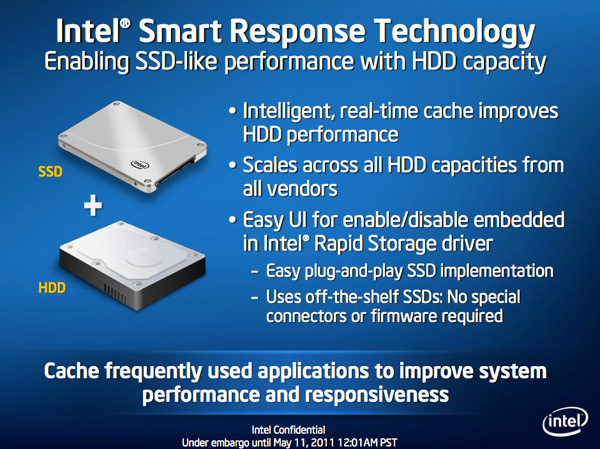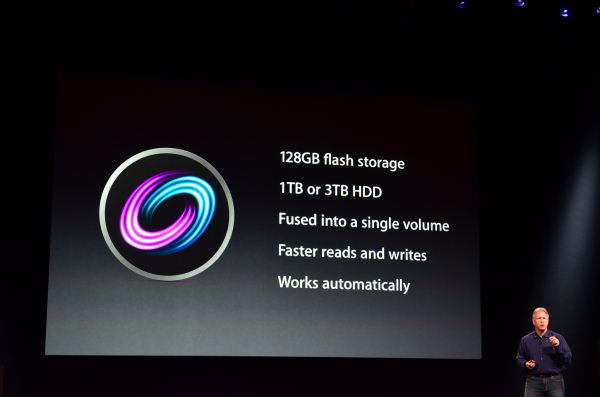A Month with Apple's Fusion Drive
by Anand Lal Shimpi on January 18, 2013 9:30 AM EST- Posted in
- Storage
- Mac
- SSDs
- Apple
- SSD Caching
- Fusion Drive
When decent, somewhat affordable, client focused solid state drives first came on the scene in 2008 the technology was magical. I called the original X25-M the best upgrade you could do for your system (admittedly I threw in the caveat that I’d like to see > 100GB and at a better price than $600). Although NAND and SSD pricing have both matured handsomely over time, there’s still the fact that mechanical storage is an order of magnitude cheaper.
The solution I’ve always advocated was a manual combination of SSD and HDD technologies. Buy a big enough SSD to house your OS, applications and maybe even a game or two, and put everything else on a RAID-1 array of hard drives. This approach works quite well in a desktop, but you have to be ok with manually managing where your files go.
I was always curious about how OEMs would handle this problem, since educating the masses on having to only put large, infrequently used files on one drive with everything else on another didn’t seem like a good idea. With its 6-series chipsets Intel introduced its Smart Response Technology, along with a special 20GB SLC SSD designed to act as a cache for a single hard drive or a bunch in an array.

Since then we’ve seen other SSD caching solutions come forward that didn’t have Intel’s chipset requirements. However most of these solutions were paired with really cheap, really small and really bad mSATA SSDs. More recently, OEMs have been partnering with SSD caching vendors to barely meet the minimum requirements for Ultrabook certification. In general, the experience is pretty bad.
Hard drive makers are working on the same problem, but are trying to fix it by adding a (very) small amount of NAND onto their mechanical drives. Once again this usually results in a faster hard drive experience, rather than an approximation of the SSD experience.
Typically this is the way to deal with hiding latency the lower you get in the memory hierarchy. Toss a small amount of faster memory between two levels and call it a day. Unlike adding a level 3 cache to a CPU however, NAND storage devices already exist in sizes large enough to house all of your data. It’s the equivalent of having to stick with an 8MB L3 cache when for a few hundred dollars more you could have 16GB. Once you’ve tasted the latter, the former seems like a pointless compromise.
Apple was among the first OEMs to realize the futility of the tradeoff. All of its mainstream mobile devices are NAND-only (iPhone, iPad and MacBook Air). More recently, Apple started migrating even its professional notebooks over to an SSD-only setup (MacBook Pro with Retina Display). Apple does have the luxury of not competing at lower price points for its Macs, which definitely makes dropping hard drives an easier thing to accomplish. Even so, out of the 6 distinct Macs that Apple ships today (MBA, rMBP, MBP, Mac mini, iMac and Mac Pro), only two of them ship without any hard drive option by default. The rest come with good old fashioned mechanical storage.
Moving something like the iMac to a solid state configuration is a bit tougher to pull off. While notebook users (especially anyone using an ultraportable) are already used to not having multiple terabytes of storage at their disposal, someone replacing a desktop isn’t necessarily well suited for the same.

Apple’s solution to the problem is, at a high level, no different than all of the PC OEMs who have tried hybrid SSD/HDD solutions in the past. The difference is in the size of the SSD component of the solution, and the software layer.










127 Comments
View All Comments
kamsar - Friday, January 18, 2013 - link
Reliability-wise isn't Fusion Drive basically RAID 0? If it's doing block level migrations and one drive dies there's nothing left.Sure hope you've got time machine on... ;)
pgp - Friday, January 18, 2013 - link
Yes, technically I think it's more similar to a JBOD configuration, but the reliability should be the same...IMHO Fusion Drive is good for noobs, but I'd rather choose which files should be stored in the flash drive and which ones in the mechanical drive, know about the free space in each disk, so I'd prefer a 128GB SSD and, separately, a 1TB hard disk to a 1.1TB Fusion Drive.
TrackSmart - Friday, January 18, 2013 - link
I think drive configurations like this are really needed. Maybe not for you and I, but for 99.5% of people. Even people who aren't really "noobs".As an example, I purchased a 120GB SSD for a family member who is reasonably good with computers. It breathed new life into a 3 year old computer and was really noticed and appreciated. One year later, the whole thing was a disaster! There are documents, music, videos, etc all over the place. Usually 2 or 3 copies of the same files on both the SSD and the hard drive. Both nearly full. It took several hours to fix the mess.
Bottom line: Most people can't, aren't willing, or aren't well-organized enough to keep files segregated between drives. Even people who you probably think would be able to handle it by virtue of being reasonably computer literate.
kmmatney - Friday, January 18, 2013 - link
I agree. I'm currently all SSD in my work laptop, but going the manual hybrid route in my home computer. Although I'm pretty organized, it is a pain to mov stuff around manually between the drives. For 2 of my kids computers, I just went with Seagate Momentus XT drives, and they've been great. Not as good as SSD, but a fraction of the cost.ToniCipriani - Friday, January 18, 2013 - link
Multiple copies could be easily avoided, actually.On my RAID-0 SSD + 1TB hard drive configuration, I installed Windows 7 in a way that all the profile folders (Users and ProgramData) existed on the hard drive by default, and created NTFS junctions on the SSD to redirect any old software. I never even needed to open the C Drive anymore, and all files and desktop settings reside on the hard drive automatically.
For older machines XP should support junctions as well.
Now filling up the drive, that's a different story. And let me guess, the browser got filled up with toolbars too?
Zink - Friday, January 18, 2013 - link
Fusion drive is even easier to use than that though and it speeds up all of your programs and files as well as it can with the SSD size given. With a setup like that there are always going to be things on the HDD that get used regularly and they will never see a boost from the SSD. There is the upside of better reliability but outside that boosting 120GB or 240GB of the most accessed files seems even better than permanent segregation.dananski - Saturday, January 19, 2013 - link
I have manual HD/SSD combinations in my desktop and laptop, have done the same for three PCs I've built for family and have similar setup for nearly every workstation at work. It seems that some users are naturally much better than others at handling their file storage, but I think it's invaluable for people to get good at organising the data systematically and consciously rather than to leave it up to an algorithm that might not have the same priorities.I don't like the sounds of every file being written to my SSD then moved to the HDD - I'd get through write cycles for no good reason whenever copying a file to that hybrid drive, and if my HDD doesn't have redundancy I'd feel safer with my important docs on the SSD, even if they're not deemed worthy of the speed boost.
seapeople - Sunday, January 20, 2013 - link
Couldn't you just put the "Pictures", "Music", and "Videos" libraries on the hard drive and keep the documents and everything else on the solid state drive? Seems to me like that would work for 99% of people and not require any user thought... So you have a video, you save it in the "Videos" location, etc, and these files would see very little difference being on the HDD vs SSD.Wolfpup - Friday, January 18, 2013 - link
Yeah, me too. Like my shows from my Tivo are obviously GIGAAAANTIC and don't NEED to have fast access to them. Ditto (even more so) for any music or iTunes stuff. It's not like it's THAT hard to figure out what to put where, but yeah, the average person unfortunately would probably be clueless about it.KitsuneKnight - Friday, January 18, 2013 - link
It's not so hard if you can get away with just moving your music/videos/images to the HDD. It's much harder if the data you work with is absolutely massive, though.One artist I know has a SSD as their boot drive, and 3 HDDs. The PSDs they work with are absolutely massive, and they produce a huge number of them. Working with them on the SSD is far better than the HDDs, but even loading them on that is a bit on the slow side (as opposed to the multi-minute loads from an HDD). But, they have far too many to fit on the SSD.
So they have the PSDs spread over the 4 drives, filling most of them up, having to manually shuffle them around. Something like Fusion Drive would work far better, as it would be doing exactly what she's doing, just without the manual effort to constantly move old files off the SSD (resulting in multiple hierarchies). The older PSDs would be migrated to the HDDs automatically. And if she starts working on an old set again, they could be promoted back to the SSD... with no user effort.
And isn't that the point of computers? To make us do less work? It seems a lot of people want to do the jobs of a computer for them. While I'd prefer Fusion Drive to let you pin/hint files to certain drives, I'd say in most cases a 2 drive set up doesn't actually provide real world benefit over an intelligent (which I'm assuming Fusion Drive is) tiering system, even for most power users.